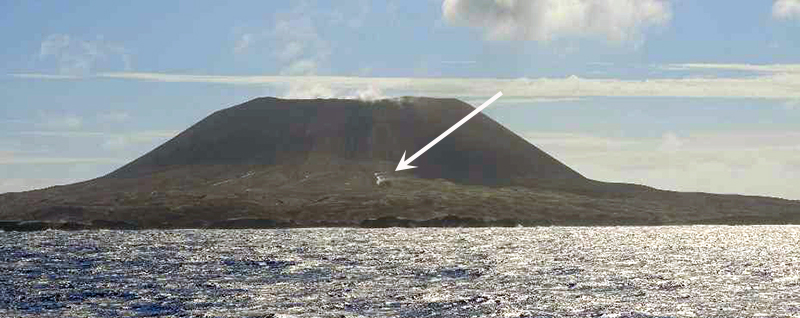Report on Nishinoshima (Japan) — February 2021
Bulletin of the Global Volcanism Network, vol. 46, no. 2 (February 2021)
Managing Editor: Edward Venzke.
Edited by A. Elizabeth Crafford.
Nishinoshima (Japan) Eruption ends in late August 2020; lengthy cooling from extensive lava flows and large crater
Please cite this report as:
Global Volcanism Program, 2021. Report on Nishinoshima (Japan) (Crafford, A.E., and Venzke, E., eds.). Bulletin of the Global Volcanism Network, 46:2. Smithsonian Institution. https://doi.org/10.5479/si.GVP.BGVN202102-284096
Nishinoshima
Japan
27.247°N, 140.874°E; summit elev. 100 m
All times are local (unless otherwise noted)
Japan’s Nishinoshima volcano, located about 1,000 km S of Tokyo in the Ogasawara Arc, erupted above sea level in November 2013 after 40 years of dormancy. Activity lasted for two years followed by two brief eruptions in 2017 and 2018. The next eruption, from early December 2019 through August 2020, included ash plumes, incandescent ejecta, and lava flows; it produced a large pyroclastic cone with a wide summit crater and extensive lava flows that significantly enlarged the island. This report covers the end of the eruption and cooling during September 2020-January 2021. Information is provided primarily from Japan Meteorological Agency (JMA) monthly reports and the Japan Coast Guard (JCG), which makes regular observation overflights.
Ash emissions were last reported on 27 August 2020. The very high levels of thermal energy from numerous lava flows, ash, and incandescent tephra that peaked during early July decreased significantly during August and September. Continued cooling of the fresh lava and the summit crater lasted into early January 2021 (figure 107). Monthly overflights and observations by scientists confirmed areas of steam emissions at the summit and on the flanks and discolored water around the island, but no eruptive activity.
Thermal activity declined significantly at Nishinoshima during August 2020 (BGVN 45:09). Only two days had two MODVOLC alerts (11 and 30), and four other days (18, 20, 21, 29) had single alerts. During JCG overflights on 19 and 23 August there were no ash emissions or lava flows observed, although steam plumes rose over 2 km above the summit crater during both visits. The last ash emission was reported by the Tokyo VAAC on 27 August 2020. No eruptive activity was observed by JMA during an overflight on 5 September, but steam plumes were rising from the summit crater (figure 108). No significant changes were observed in the shape of the pyroclastic cone or the coastline. Yellowish brown discolored water appeared around the western half of the island, and high temperature was still measured on the inner wall of the crater. Faint traces of SO2 plumes were present in satellite images in early September; the last plume identified was on 18 September. Six days with single MODVOLC alerts were recorded during 3-19 September, and the final thermal alert appeared on 1 October 2020.
Steam plumes and high temperatures were noted at the summit crater on 28 October, and brown discolored water was present around the S coast of the island (figure 109), but there were no other signs of volcanic activity. Observations from the sea conducted on 2 November 2020 by researchers aboard the Maritime Meteorological Observatory marine weather observation ship "Ryofu Maru" confirmed there was no ongoing eruptive activity. In addition to steam plumes at the summit, they also noted steam rising from multiple cracks on the cooling surface of the lava flow area on the N side of the pyroclastic cone (figure 110). Only steam plumes from inside the summit crater were observed during an overflight on 24 November.
JMA reduced the warning area around the crater on 18 December 2020 from 2.5 to 1.5 km due to decreased activity. On 7 December a steam plume rose from the inner wall of the summit crater and thermal imaging indicated the area was still hot. Brown discolored water was observed on the SE and SW coasts. Researchers aboard a ship from the Earthquake Research Institute at the University of Tokyo and the Marine Research and Development Organization reported continued steam plumes in the summit crater, around the lava flows on the N flank, and along the S coast during 15-29 December (figure 111). Steam plumes and elevated temperatures were still measured inside the summit crater during an overflight by the Japan Coast Guard on 25 January 2021, and discolored water persisted on the SE and SW coasts; there was no evidence of eruptive activity.
Geological Summary. The small island of Nishinoshima was enlarged when several new islands coalesced during an eruption in 1973-74. Multiple eruptions that began in 2013 completely covered the previous exposed surface and continued to enlarge the island. The island is the summit of a massive submarine volcano that has prominent peaks to the S, W, and NE. The summit of the southern cone rises to within 214 m of the ocean surface 9 km SSE.
Information Contacts: Japan Meteorological Agency (JMA), 1-3-4 Otemachi, Chiyoda-ku, Tokyo 100-8122, Japan (URL: http://www.jma.go.jp/jma/indexe.html); Japan Coast Guard (JCG) Volcano Database, Hydrographic and Oceanographic Department, 3-1-1, Kasumigaseki, Chiyoda-ku, Tokyo 100-8932, Japan (URL: http://www.kaiho.mlit.go.jp/info/kouhou/h29/index.html); Volcano Research Center (VRC-ERI), Earthquake Research Institute, University of Tokyo, Yayoi 1-1-1, Bunkyo-ku, Tokyo 113, Japan (URL: http://www.eri.u-tokyo.ac.jp/topics/ASAMA2004/index-e.html); Hawai'i Institute of Geophysics and Planetology (HIGP) - MODVOLC Thermal Alerts System, School of Ocean and Earth Science and Technology (SOEST), Univ. of Hawai'i, 2525 Correa Road, Honolulu, HI 96822, USA (URL: http://modis.higp.hawaii.edu/); MIROVA (Middle InfraRed Observation of Volcanic Activity), a collaborative project between the Universities of Turin and Florence (Italy) supported by the Centre for Volcanic Risk of the Italian Civil Protection Department (URL: http://www.mirovaweb.it/); NASA Global Sulfur Dioxide Monitoring Page, Atmospheric Chemistry and Dynamics Laboratory, NASA Goddard Space Flight Center (NASA/GSFC), 8800 Greenbelt Road, Goddard, Maryland, USA (URL: https://so2.gsfc.nasa.gov/).






